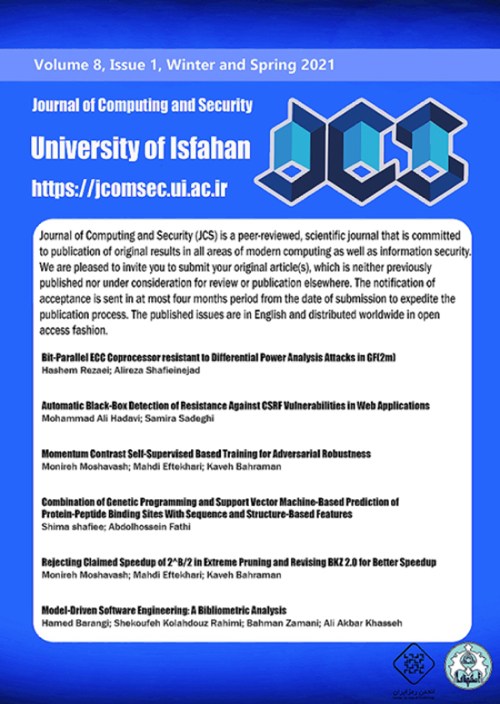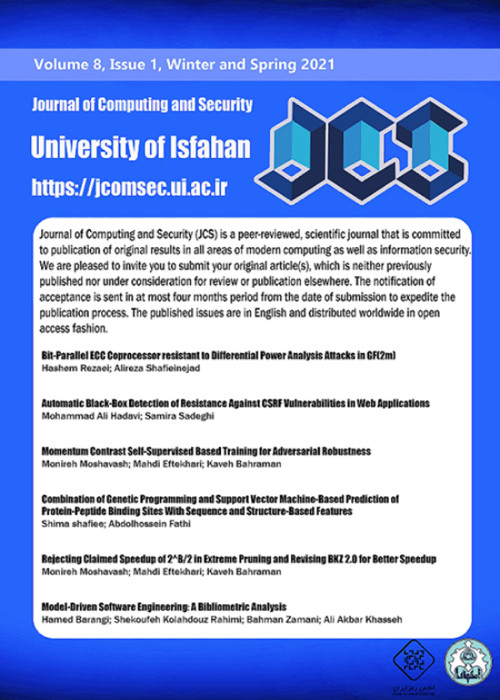فهرست مطالب

Journal of Computing and Security
Volume:9 Issue: 2, Summer and Autumn 2022
- تاریخ انتشار: 1401/10/04
- تعداد عناوین: 4
-
-
Pages 1-10Since the most critical constituent of the cost of cryptocurrency production is energy bills, the use of illegal electricity in cryptocurrency mining farms is very common. Illegal mining farms have popped up throughout Iran in recent years. They use large collections of computer servers to verify bitcoin transactions, a highly energy-intensive process that can sap hundreds of megawatts from the power grid, which might lead to several large cities facing daily power outages. Therefore, it is essential to detect illegal miners. Although illegal miner detection might seem like a common anomaly detection problem at first glance, the results reported by different power distribution companies in Iran show that the behavior of many normal customers might be very similar to the customers’ that have some illegal miners. In addition, power distribution companies prefer models that can recognize useful insights into the behavioral patterns of the customers. To the best of our knowledge, for the first time, this paper proposes a novel classIfier for miNer detection Based On patteRn miNing (INBORN) that considers the correlation between different attributes and extracts the behavioral patterns of costumers explicitly. INBORN consists of two steps: in the first step, the frequent patterns are extracted and the attributes separating miners and non-miners are determined. In the next step, a decision tree is learned based on the frequency of the patterns. Since the Power Distribution Company of Markazi province is a pioneer in the field of illegal miner detection in Iran, the performance of INBORN is evaluated based on real datasets provided by this company. The experimental results show that INBORN improves the classification accuracy compared to the common algorithms and systems used in the Power Distribution Company of Markazi province.Keywords: Miner Detection, Energy Consumption, Data Mining, Behavioral Pattern
-
Pages 11-22Different programmers code in different ways. Knowing these habits and the human factors that affect them significantly impacts teaching and task assignments in programming. This article examines the effect of cognitive style on programming habits. We used a questionnaire to obtain data on cognitive style, programming experience, programming skill, interest in programming, and programming habits from 275 student programmers. After preprocessing and feature selection, we evaluated the effectiveness of different data mining techniques in estimating programming habits. Using the Support Vector Machine, the most effective method, we predicted each programming habit once without cognitive style and the second time with cognitive style. The results showed that cognitive style affects the programming habit of "systematic debugging" with Glass's Delta value = 0.22. Programmers with a median score in cognitive style, both analytic and Intuitive, more often debug their codes systematically than programmers with lower or higher scores in cognitive style. Thus assigning programmers with both Intuitive and analytic talent would be more effective when projects need systematic debugging. Moreover, trainers should pay more attention to only Intuitive or only analytical students when teaching systematic debugging. We recommend teachers, trainers, and managers consider cognitive style in programming.Keywords: Computer Programming, Programming Habits, Human Factors, Cognitive Style, Data Mining
-
Pages 23-38Influence maximization in social networks is defined as determining a subset of seed nodes where triggering the influence diffusion through the social network leads to the maximum number of final influenced nodes. The tradeoff between the runtime efficiency and effectiveness in the quality of response is the main issue in presenting solutions for this NP-hard optimization problem. Centrality-based methods are applied as a category of efficient heuristic-based solutions to this problem. The two leading causes of losing effectiveness in centrality-based methods are 1) only the link structure and non-awareness of influence diffusion are considered in determining the importance of nodes, and 2) influence overlap exists among selected seed nodes. To address the first cause, an influence-aware betweenness centrality measure is proposed considering both IC and LT models. Moreover, an existing influence-aware closeness centrality measure for LT model is adopted to cover both LT and IC models. To address the second cause, a greedy-based method is proposed by applying influence-aware centrality measures to identify the influential nodes, next to proposing a Jacquard-based measure to overcome the influence overlap problem. The experiments consist of two parts where two real-world datasets are applied: 1) the proposed influence-aware centrality measures are compared with their original versions, and 2) the greedy-based method is compared with benchmark methods. The results indicate the effectiveness of the influence-aware centrality measures and the proposed greedy-based method in maximizing the influence spread in social networks.Keywords: Influence-based centrality measure, Betweenness, closeness
-
Pages 39-54Mobile applications are playing an important role in our digital lives. App stores can be considered key components in the ecosystem of mobile applications. They assist users to ensure the authenticity of applications and protecting the intellectual property rights of application developers. In this paper, we introduce an autonomous decentralized mobile application distribution platform (app store) and a license management solution that utilizes a public blockchain and operates by smart contracts. We identify developers by their decentralized and self-sovereign identities, verify the integrity of the applications according to the secure information on the blockchain, and implement a fully autonomous license management solution by non-fungible tokens (NFT) on the blockchain. We deploy a proof-of-concept implementation of our proposal written in Solidity language on the Ropsten (Ethereum) and RSK testnets, and evaluate its latency and costs. Our comparison with the related works demonstrates that our proposal ranks atop the related works.Keywords: App Store, Blockchain, Smart Contract, Software License Management, Decentralized Identifier, Self-Sovereign Identity, Non-Fungible Token (NFT)


